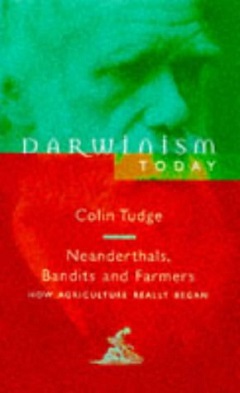Neanderthals, Bandits and Farmers
Neanderthals, Bandits, and Farmers: How Agriculture Really Began is a pivotal work that explores the origins of agriculture and its profound impact on human society. This article delves into the theories and evidence presented in the book, shedding light on the transition from hunter-gatherer societies to settled farming communities, a transformation that has shaped the course of human history.
Overview[edit | edit source]
The book posits that the advent of agriculture was not a straightforward or uniform process but rather a complex evolution influenced by various factors including climate change, population pressures, and interactions between different human groups. The title itself - Neanderthals, Bandits, and Farmers - encapsulates the main actors in this narrative: the Neanderthals, representing the pre-existing hunter-gatherer populations; the 'bandits', symbolizing the dynamic and often violent interactions between groups; and the 'farmers', denoting the communities that adopted and refined agricultural practices.
Neanderthals[edit | edit source]
Neanderthals were an early human species that lived in Europe and parts of Asia until about 40,000 years ago. They were adept hunters and gatherers, with a deep understanding of their natural environment. The book explores how Neanderthals might have interacted with early modern humans and the role these interactions played in the development of agriculture. It challenges the notion that Neanderthals were simply replaced or outcompeted by more 'advanced' Homo sapiens, suggesting instead that the exchange of knowledge and culture between these groups was a crucial factor in the agricultural revolution.
Bandits[edit | edit source]
The 'bandits' in the narrative refer to mobile groups of humans who, driven by various pressures, raided and interacted with established communities. These interactions were not solely destructive; they also facilitated the exchange of goods, knowledge, and genetic material. The book examines how these dynamics contributed to the spread of agricultural practices, as communities sought to defend themselves against raids or adopted new strategies for food production to support larger populations.
Farmers[edit | edit source]
The transition to farming is depicted as a gradual process, influenced by the changing climate, the availability of domesticable plants and animals, and the innovations brought about by human ingenuity. The book highlights the diversity of agricultural practices that emerged around the world, from the rice terraces of East Asia to the maize fields of the Americas. It argues that the shift to farming was not merely a technological revolution but a profound change in the human relationship with the environment, leading to the establishment of permanent settlements, the development of social hierarchies, and the rise of complex civilizations.
Impact on Human Society[edit | edit source]
The adoption of agriculture is shown to have had far-reaching effects on human society. While it enabled the support of larger populations and the development of cities and states, it also introduced new challenges, including social inequality, disease, and environmental degradation. The book discusses how these issues have persisted into the modern era, influencing contemporary debates on sustainability, food security, and social justice.
Conclusion[edit | edit source]
Neanderthals, Bandits, and Farmers: How Agriculture Really Began offers a comprehensive and nuanced exploration of the origins of agriculture and its lasting impact on human society. By integrating insights from archaeology, anthropology, and genetics, the book provides a multifaceted understanding of one of the most significant transformations in human history.
Search WikiMD
Ad.Tired of being Overweight? Try W8MD's physician weight loss program.
Semaglutide (Ozempic / Wegovy and Tirzepatide (Mounjaro / Zepbound) available.
Advertise on WikiMD
|
WikiMD's Wellness Encyclopedia |
| Let Food Be Thy Medicine Medicine Thy Food - Hippocrates |
Translate this page: - East Asian
中文,
日本,
한국어,
South Asian
हिन्दी,
தமிழ்,
తెలుగు,
Urdu,
ಕನ್ನಡ,
Southeast Asian
Indonesian,
Vietnamese,
Thai,
မြန်မာဘာသာ,
বাংলা
European
español,
Deutsch,
français,
Greek,
português do Brasil,
polski,
română,
русский,
Nederlands,
norsk,
svenska,
suomi,
Italian
Middle Eastern & African
عربى,
Turkish,
Persian,
Hebrew,
Afrikaans,
isiZulu,
Kiswahili,
Other
Bulgarian,
Hungarian,
Czech,
Swedish,
മലയാളം,
मराठी,
ਪੰਜਾਬੀ,
ગુજરાતી,
Portuguese,
Ukrainian
Medical Disclaimer: WikiMD is not a substitute for professional medical advice. The information on WikiMD is provided as an information resource only, may be incorrect, outdated or misleading, and is not to be used or relied on for any diagnostic or treatment purposes. Please consult your health care provider before making any healthcare decisions or for guidance about a specific medical condition. WikiMD expressly disclaims responsibility, and shall have no liability, for any damages, loss, injury, or liability whatsoever suffered as a result of your reliance on the information contained in this site. By visiting this site you agree to the foregoing terms and conditions, which may from time to time be changed or supplemented by WikiMD. If you do not agree to the foregoing terms and conditions, you should not enter or use this site. See full disclaimer.
Credits:Most images are courtesy of Wikimedia commons, and templates Wikipedia, licensed under CC BY SA or similar.
Contributors: Prab R. Tumpati, MD

